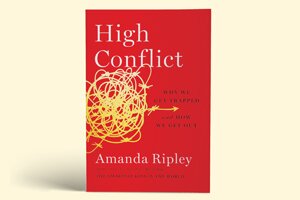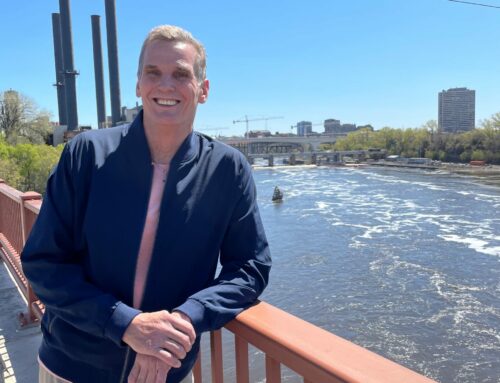Written by Dr. William Doherty and Shauna Fenske
Originally Published in Psychotherapy Networker
May/June 2022
 High Conflict: Why We Get Trapped and How We Get Out
High Conflict: Why We Get Trapped and How We Get Out
By Amanda Ripley
New York: Simon & Schuster, 2021
No one needs a reminder that we live in a world of high conflict, from toxic political polarization to screaming matches at once-boring schoolboard meetings to Academy Award slap-downs to flights redirected because of mask-refusing passengers. Our clients have told us about family cutoffs over politics and vaccine-driven boycotts of Thanksgiving dinners, birthday parties, and weddings. High conflict is everywhere, it seems.
But for author Amanda Ripley, high conflict is not mainly a matter of frequency or degree—lots of conflicts or more intense conflicts—but something qualitatively different. It’s conflict that takes on a life of its own, feeding off itself, sucking its participants into a cyclone that feels beyond their control. It’s often fueled by third parties like media personalities, in the case of political polarization, or like divorce attorneys, in the case of high conflict divorces. Therapists see the effects of it in our clients and their relationships, and we can feed its flames ourselves if we’re not careful. More on that later.
Conflict, to be sure, can be necessary and good. Healthy conflict, Ripley writes, is a way to deal with tension on a specific issue. It creates pressure to create and sustain change. It arises, is dealt with, and then subsides. The participants maintain their relationship and their dignity. High conflict is a different animal. In Ripley’s words: “When conflict escalates past a certain point, the conflict itself takes charge. The original facts and forces that led to the dispute fade into the background. The us-versus-them dynamic takes over. Actual differences of opinion . . . stop mattering, and the conflict becomes its own reality. High conflict is the invisible hand of our time.”
A journalist who spent five years studying conflict, interviewing experts, and observing groups trying to prevent high conflict, Ripley makes her most compelling points through stories. Curtis Toler, a former gang leader in Chicago, learned to head off “accelerants” or “fire starters” that turn ordinary relationship conflict into street violence. “Roly” Matalon and his liberal Jewish congregation decided to visit and then host conservative Christians from a different part of the country. Guerilla fighter Sandra Milena Vera Bustos of Columbia found pathways out of the conflict ravaging her country. The most gripping story for therapists, though, is about Gary Friedman, a world-renowned mediator, who became an instigator of high conflict in his own town when he decided to enter politics.
Gary was a collaborative divorce pioneer, whose career evolved into working on conflict resolution in corporations and communities. By the time he decided to apply his skills to his own small community by running to head a town council riven by seemingly petty conflicts, he understood the contours of conflict at a deep level. He was skilled at asking good questions to uncover the understory. He was comfortable sitting with tension in small and large groups as they developed understanding. He maintained a stance of curiosity. He helped adversaries feel heard. What’s more, he’d lived in this town for four decades and had raised his family there.
Gary hired a neighbor with experience in politics as his advisor, and he developed two major slogans for his platform: “a new way to do politics” and, on his advisor’s advice, “out with the old guard.” He was swept into office after the largest voter turnout in many years, and on February 3, 2016, he presided over his inaugural meeting as president of Muir Beach District Board of Directors.
As you might’ve guessed, trouble had already been brewing with the old guard, who felt name-called, disrespected, and pushed aside by his campaign. Unphased, Gary created a new set of rules, created a dozen new subcommittees, and made changes aimed at being more democratic and inclusive. The pushback from members of the old guard was swift, and meetings became tense, as Gary found himself spending a lot of energy trying to enforce his rules, which he called Principles of Unity, and which stated, for example, that nothing could be introduced at meetings unless it was on the written agenda.
Although even his wife told him he was being rigid as he ran the meetings, he maintained that the problem wasn’t with him, but with the old guard. Word spread that he was inflexible and even tyrannical. With every decision he made, the divide kept getting wider. His every effort to diffuse conflict made it worse. At this point, his identity as someone who heals conflict was being threatened. He found himself feeling deeply bothered, rejected, and underappreciated by the community that he was trying to help.
By the summer of 2017, Gary was feeling trapped by the increasingly appalling claims against him. Another election was approaching, and he feared losing the few allies he had on the council. He wrote an accusatory letter about the old guard and posted it online, even though he knew this wasn’t right. When he was challenged about the letter at the next meeting, he refused to discuss it, saying he was being personally attacked. An early supporter then declared he was going to file a motion to remove Gary from his position. Although that motion didn’t pass, his closest allies did get voted out in the next election and were replaced by, you guessed it, members of the old guard. The new leadership reversed almost everything Gary had done. He felt humiliated.
At this point, Gary realized that two years of his life had been subsumed by a vortex of high conflict. He’d disappointed his family, alienated his neighbors, and sacrificed his peace of mind. He wrestled with a decision to resign, which felt like failure, or to stick it out, which came with the hope that he might redeem himself. He decided to stay in office and started making small moves, such as voting with his opponents on certain matters in order to disrupt the cycle of conflict.
In the end, Gary did something he’d helped his clients do for four decades: he grounded himself in what he believed to be most important: understanding others, rather than fighting them. Importantly, he distanced himself from his political advisor. His relationships with the old guard and the community started to mend. Normal conflict remained, and he had to let go of hurt, but high conflict no longer dominated his life and his town, where he stayed and refound himself.
High Conflict in the Therapy Room?
So what are the implications of Gary’s story for therapists who deal not with political conflict, but with everyday interpersonal conflict? Relational conflicts, of course, are a major grist for conversations in the therapy space, and presumably we see ourselves as helping our clients engage in healthy conflict and avoid high conflict. Although Ripley doesn’t address psychotherapy in particular, the implication for therapists is clear: use a systemic frame to understand what’s going on and see the big picture, the ways that conflict can escalate and feed on itself, often with our client’s active participation. And understand that we, too, are prone to personalizing conflict and making it worse.
Unfortunately, few therapists nowadays are trained to think this way. When we see our clients caught up in high conflict, the default is to focus on the individuals involved, their personalities and individual behavior. We think about difficult people but not the difficult systems that our client is caught up in and often contributing to.
It’s not that systemic thinking is outside the heritage of psychotherapy. The anthropologist and family therapy pioneer Gregory Bateson got there first during his studies of tribal communities in the South Pacific. He observed how tribal neighbors sometimes got into cycles of escalating conflict that couldn’t be explained based on what each tribe was like—peaceful, warlike, and so forth. Something happened when conflict broke out that took on a life of its own. Small skirmishes led to war, and war led to more intense war until something happened to kick off a de-escalation process.
At Bateson’s time, in the 1930s, there were two reigning explanations of human conflict: microlevel conflict was caused by intrapsychic factors (à la Freud) and macrolevel conflict was caused by sociopolitical factors (touted by political scientists). Bateson and later family therapists focused on a new level—the “in-between”—patterns of interaction that are more than a product of the characteristics of the individual participants in the conflict or their larger social environment. When people dance together, the dance itself becomes a new cocreated reality. What’s more, as family therapists Murray Bowen and Salvador Minuchin pointed out, intense two-party conflicts (the toxic tango) generally involve third parties that accelerate the conflict. In sum, systemic forces drive couples, families, groups, and nations to say and do things that aren’t “who they are,” all the while feeling justified that they’re just responding to the bad actions of the other.
This essential systemic insight, which Ripley believes is the key to understanding high conflict, was always a hard sell in the therapy field, given our psychodynamic origins. Then the DSM and the insurance-based medical model sidelined systemic thinking. As a result, we’re adept at diagnosing individuals but not systemic interactions, and thus miss opportunities to help our clients avoid and escape the fires of high conflict. Even worse, we can become fire accelerants, as in cases of divorce.
Ask the average therapist to explain a particular high-conflict divorce and you’re likely to hear about narcissism and attachment wounds, not so much about runaway escalation aided by third parties. This individualistic understanding of systemic conflict is conceptually limited and perpetuates a toxic societal divorce system, as divorce lawyers see themselves not as enablers of high conflict but gladiators protecting their clients from antisocial or narcissistic ex-spouses.
Understandably, the emotional pain and fear of being taken advantage of by someone they trusted can lead clients to assign full blame for conflict to their partner. And as compassionate helpers, we therapists are tempted to side fully with the client’s perspective, often dressing it up with diagnostic language. An informal poll among colleagues yields the following standard diagnoses of ex-spouses the therapist has never met: husbands are usually narcissists and wives, are, you guessed it, borderlines. Thus, we weaponize the tools of our trade and inch standard-divorce conflicts toward the quicksand of high conflict.
Rethinking Conflict
Reading Ripley’s book reminded one of us of a sobering case. A couple came to me (Shauna) hoping to recover from the wife’s infidelity. But after a difficult six months of therapy, the husband found out the affair hadn’t actually ended. Following a short-lived attempt to continue therapy, the couple decided to separate. The husband wanted to continue with his own individual sessions and the wife supported the idea. From that point on, I found myself less ethically accountable to the wife and the couple relationship and more responsible for supporting the husband’s narrative about his pain. Their relationship become increasingly negative and the husband increasingly righteous, which carried over into the divorce process and their coparenting.
At the time, I felt justified. After all, the wife had lied during the therapy, and the husband was manipulated and deceived. (The wife subsequently said she’d ended the affair, but the husband’s narrative of unilateral victimization was unbendable, with my support.) Later, I came to realize that I’d become an emotional lawyer for my client and had lost the systemic perspective I’d had when I was treating them as a couple. I was like Gary. I knew better, but when my context changed (in my case, from relationship supporter to individual advocate; for Gary, from mediator to politician), I reverted to the cultural norm of good guys versus bad guys.
If we can be unwitting agents of high conflict, we can also help clients prevent and mitigate it. Fortunately, one of the main things we’re good at as therapists—listening to understand—is necessary for preventing runaway conflict. In Ripley’s words: “Almost no one changes until they feel heard. That’s the . . . paradox of conflict. People need to believe you understand them, even as they realize you disagree, before they will hear you. Many disputes devolve into a game of chicken because of this paradox. Who is going to dare to listen first?”
This is easier to accomplish in couples therapy because we have both parties in the room; couples can follow our lead as we show understanding of each of them. The greater challenge for therapists is how to encourage our clients to dare to listen in their conflicts with people who aren’t in therapy with us. It requires us to imagine the pain and perspectives of people who are causing our clients distress, including difficult parents, siblings, adult children, and ex-spouses—and to consider how our clients might be causing them distress. We must visualize the dance when we can’t see the dancers together. We must side with our client but not against anyone, lest we be agents of high conflict.
In the end, systemic forces are not destiny. People create them and can change them. Here is Ripley’s way out of high conflict: “The goal is to understand high conflict better, so we can see it coming—and help ourselves or other people shift out of it, if we want to. Which leads to the most interesting mystery of all. People do escape high conflict. Individuals—even entire communities—find ways to short-circuit the feedback loops of conflict. They don’t suddenly agree, and this is important: they don’t surrender their beliefs. Nor do they defect, switching from one position to the opposite extreme. Instead, they do something much more interesting: they become capable of comprehending that with which they still disagree. Like someone who learns a second language, they start to hear the other side without compromising their own beliefs. And that changes everything. Curiosity returns. Humanity revives. IQs go back up. Conflict becomes necessary and good, instead of just draining.”
* * * *
William Doherty, PhD, is Professor of Family Social Science and Director of the Minnesota Couples on the Brink Project at the University of Minnesota, and author of the book The Ethical Lives of Clients: Transcending Self-Interest in Psychotherapy.
Shauna Fenske, MA, LMFT, is a doctoral student in the Family Social Science and Couple and Family Therapy Specialization Program at the University of Minnesota.



